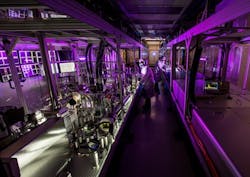LLNL HAPLS petawatt laser reaches highest average power; ready for delivery to ELI Beamlines
The High-Repetition-Rate Advanced Petawatt Laser System (HAPLS), being developed at Lawrence Livermore National Laboratory (LLNL; Livermore, CA), recently completed a significant milestone: demonstration of continuous operation of an all diode-pumped, high-energy femtosecond petawatt laser system. With completion of this milestone, the system is ready for delivery and integration at the European Extreme Light Infrastructure Beamlines facility project (ELI Beamlines) in the Czech Republic.
RELATED ARTICLE: Four 800 kW laser diode arrays to pump high-pulse-rate HAPLS petawatt laser
HAPLS set a world record for diode-pumped petawatt lasers, with energy reaching 16 J and a 28 fs pulse duration (equivalent to approximately 0.5 PW/pulse) at a 3.3 Hz repetition rate and in just three years, HAPLS went from concept to a fully integrated and record-breaking product.
"Lawrence Livermore takes pride in pushing science and technology to regimes never achieved before," LLNL Director Bill Goldstein said. "Twenty years ago, LLNL pioneered the first petawatt laser, the NOVA Petawatt, representing a quantum leap forward in peak power. Today, HAPLS leads a new generation of petawatt lasers, with capabilities not seen before."
In the decades since high-power lasers were introduced, they have illuminated entirely new fields of scientific endeavor, in addition to making profound impacts on society. When petawatt peak power pulses are focused to a high intensity on a target, they generate secondary sources such as electromagnetic radiation (for example, high-brightness X-rays) or accelerate charged particles (electrons, protons or ions), enabling unparalleled access to a variety of research areas, including time-resolved proton and X-ray radiography, laboratory astrophysics and other basic science and medical applications for cancer treatments, in addition to national security applications and industrial processes such as nondestructive evaluation of materials and laser fusion.
Drawing on LLNL's decades of cutting-edge laser research and development led to the key advancements that distinguish HAPLS from other petawatt lasers. Those advancements include HAPLS' ability to reach petawatt power levels while maintaining an unprecedented pulse rate; development of the world's highest peak power diode arrays, driven by a Livermore-developed pulsed power system; a pump laser generating up to 200 J at a 10 Hz repetition rate; a gas-cooled short-pulse titanium-doped sapphire amplifier; a sophisticated control system with a high level of automation including auto-alignment capability, fast laser startup, performance tracking and machine safety; dual chirped-pulse-amplification high-contrast short-pulse front end; and a gigashot laser pump source for pumping the short-pulse preamplifiers. In addition, HAPLS is to be the most compact petawatt laser ever built.
This expertise is why ELI Beamlines looked to Livermore to develop HAPLS. "It was quite straightforward," said Roman Hvezda, ELI Beamlines project manager. "Given the design requirements, nobody else could deliver this system in such a short time on schedule and on budget. It's a great benefit to be able to cooperate with Livermore, a well-established lab, and this will be a basis for continued cooperation in the future."
This cooperation was daily during construction, with LLNL and ELI Beamlines scientists and engineers working side by side on all parts of the laser system. In the coming months, HAPLS will be transferred to ELI Beamlines, where it will be integrated into the facility's laser beam transport and control systems, then brought up to full design specification - delivery of pulses with peak power exceeding 1 petawatt (quadrillion watts) firing at 10 Hz, breaking its own record and making it the world's highest average power petawatt system. ELI plans to make HAPLS available by 2018 to the international science user community to conduct the first experiments using the laser.
SOURCE: LLNL; https://www.llnl.gov/news/llnl-meets-key-milestone-delivery-world%E2%80%99s-highest-average-power-petawatt-laser-system

Gail Overton | Senior Editor (2004-2020)
Gail has more than 30 years of engineering, marketing, product management, and editorial experience in the photonics and optical communications industry. Before joining the staff at Laser Focus World in 2004, she held many product management and product marketing roles in the fiber-optics industry, most notably at Hughes (El Segundo, CA), GTE Labs (Waltham, MA), Corning (Corning, NY), Photon Kinetics (Beaverton, OR), and Newport Corporation (Irvine, CA). During her marketing career, Gail published articles in WDM Solutions and Sensors magazine and traveled internationally to conduct product and sales training. Gail received her BS degree in physics, with an emphasis in optics, from San Diego State University in San Diego, CA in May 1986.
